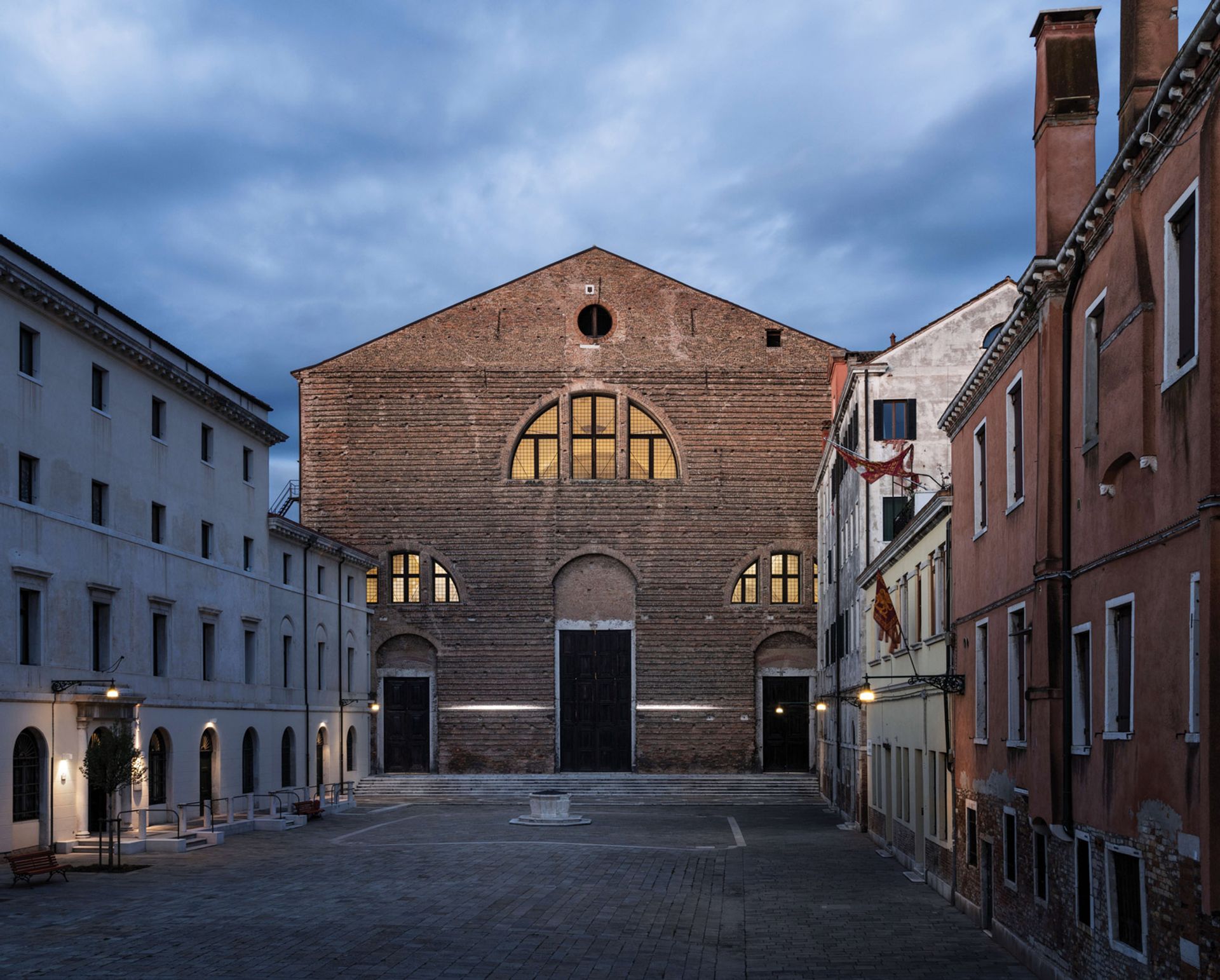The Byzantine church of San Lorenzo is the fabled resting place of the explorer Marco Polo. Rebuilt between 1592 and 1602 and deconsecrated in 1810, it was transformed by Renzo Piano into the setting for Luigi Nono’s opera Prometeo during the 1984 Venice Biennale. The church embodies Venice’s Unesco World Heritage status as “a unique artistic achievement”, but it also encapsulates the pressing existential threat confronting the city. In March 2019, it reopened after a two-year restoration as Ocean Space, an “embassy for the oceans” funded by TBA21- Academy, an offshoot of the Austrian art foundation Thyssen-Bornemisza Art Contemporary.
A light installation now runs horizontally across San Lorenzo’s façade, denoting the height the Intergovernmental Panel on Climate Change predicts Venice’s waters will reach by 2100—6m above sea level—leaving much of the city uninhabitable and destroying its centuries-old cultural heritage.
"Venice is at the frontline of climate change in Europe"Markus Reymann, co-founder of TBA21-Academy
Inside is the exhibition Oceans in Transformation, born of a three-year research project between the architectural and advocacy group Territorial Agency and hundreds of scientists, marine biology institutions and intergovernmental organisations. Ann-Sofi Rönnskog and John Palmesino, the group’s founders, say the show explores how “what just a few years ago seemed to be a distant future is happening now”. They found “a way to display a potential history in the making”, says Daniela Zyman, the curator of the exhibition, which is co-produced by Luma Foundation. “Art can facilitate and communicate issues in a way science cannot.”
The threat of rising sea levels puts Venice “at the frontline of climate change in Europe”, says Markus Reymann, who co-founded TBA21-Academy with the collector Francesca von Habsburg. “Venice has this incredibly intimate relationship to this very precarious environment. It made so much sense to bring Ocean Space here.”

A light installation on the facade of San Lorenzo church denotes the height the Intergovernmental Panel on Climate Change predicts Venice’s waters will reach by 2100—6m above sea level Photo: Marco Cappelletti
The show opened in August, after months when Venetians witnessed the city without the usual crush of tourists—previously around 25 million a year. Without the churn of boats, the waters ran clear and were full of colourful plants and sea creatures rarely seen before. Fish are still swimming in unprecedented numbers through the waterways.
The reprieve from the pressures of commerce is driving a new debate among locals over how to protect their city. The writer and curator Barbara Casavecchia, a mentor of the artists and scientists of Oceans in Transformation, recalls walking around Venice as lockdown eased. “It was very emotional,” she says. “Beforehand, institutions felt they needed to welcome people in huge numbers in order to survive. That vertical model is broken, I think.”
Venice’s fragility became clear last November, when more than 80% of the city was flooded by the second-highest tide ever recorded, which reached a peak of 1.87m. The mayor, Luigi Brugnaro, declared a state of emergency and called on the Italian government to “listen” to the “effects of climate change”.
St Mark’s Basilica, the Doge’s Palace, La Fenice opera house and 85 churches were waterlogged. The Querini Stampalia Foundation, a private collection and library whose 1960s restoration by Carlo Scarpa was “conceived as co-existing with water”, Casavecchia says, sustained around €500,000 of damage.
"Unless we act together at the highest levels, Venice has had it by the end of this century"Anna Somers Cocks, founder of The Art Newspaper
Anna Somers Cocks, the former chair of the Venice in Peril Fund and the founder of The Art Newspaper, points out that acute flooding events like the November storm “are not the main problem”. The rising water is “a chronic condition”, she says. In a city built on a base of dense and impermeable Istrian stone, water is now “reaching the brickwork of many historic buildings; it is soaking into their foundations”.
Despite, and, in some ways, because of the pandemic, some progress is now being made. On 10 July, the pause in activity allowed for the first full test of Mose, a system of 78 mobile floodgates installed at the city’s Lido, Malamocco and Chioggia inlets, funded by the Italian government’s infrastructure ministry. The flood barriers successfully blocked a high tide of 1.3m on 3 October. The project has cost billions of euros since construction began in 2003 and was engulfed in a corruption scandal in 2014, involving then mayor Giorgio Orsoni.
The government now expects Mose to be completed and handed over to the city council by the end of 2021. Even if that deadline is met, “it will only give us time to think about what to do next,” Somers Cocks says. “As of now, the barriers are late. And no thinking has taken place. Unless we act together at the highest levels, Venice has had it by the end of this century.”
• Territorial Agency: Oceans in Transformation, Ocean Space, Venice, until 29 November


